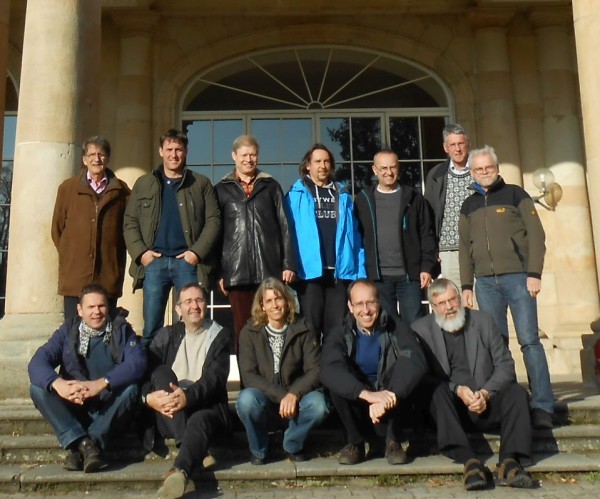WG Soil Systematics
Albrecht Bauriegel/DBG
WG Soil Systematics

Back row from left to right: Reinhold Jahn, Michael Margret, Dieter Kühn, Günter Aust, Reinhard Jochum, Alexander Gröngröft Peter Schad, sitting in front: Wolfgang Fleck, Gerhard Milbert, Daniela Sauer, Einar Eberhardt, Karl Stahr
Portrait
The Soil Systematics Working Group of the German Soil Science Society has the task of further developing the German Soil and Substrate Systematics according to the current state of soil scientific knowledge on pedogenesis and the properties of the soils of Central Europe. It prepares and presents the results for soil scientists, authorities working on soils, for educational and professional training and the interested public. It is traditionally made up of members half from the state geological services of the German federal states and half from Universities. This is to ensure that both findings from soil survey and soil genesis are incorporated into the systematics. The working group maintains contact with colleagues working on soil systematics in Germany's neighbouring countries, with permanent guests from Switzerland, Austria and Luxembourg.
The working group was founded in 1952 at the bi-annual conference of the German Soil Science Society in Bad Kreuznach as Commission for Soil Systematics. Since then, it has developed the German soil system as a commission, then as a working group and since 2009 as a working group. Over time, a systematic classification of soil-forming substrates and a classification of soil communities have been added as further tasks. These classifications are also being continuously developed.
A detailed description of the activities over time is published in the Mitteilungen der Bodenkundlichen Gesellschaft (WITTMANN O.(2002): Der Arbeitskreis für Bodensystematik der DBG.- In: Bodenkundliche Mitteilungen, 102, Oldenburg; in German). The previous members of the working group and the duration of their collaboration are also summarised there in an overview.
Activities
The Soil Systematics Working Group meets twice a year to follow up on its projects. In addition, one field trip a year is organised where possible, to review the systematics or to discuss proposals in the field. Furthermore, it participates in student‘s and professional education and training events, such as the Soil Contest, in Commission V field workshops on the working group’s topics (e.g. on the properties and description of periglacial layers) and maintains contact with the Humus Forms Working Group and the Urban Soils Working Group. It also participates with some members in the World Reference Base for Soil Resources working group of the International Union of Soil Science (IUSS). At the annual conferences of the DBG, the working group assists with the preparation of the excursion guides from a soil systematics perspective.
Currently, the working group is documenting the decisions made for the soil and substrate systematics as given in the Soil Survey Guidelines (Bodenkundliche Kartieranleitung), 6th edition.
The Soil Systematics Working Group welcomes new members, especially from university research. Beside an interest in soil systematics issues and corresponding knowledge of soil genesis and soil-forming processes, the main prerequisite is a willingness and ability to work in the group on a long-term basis. Please contact E. Eberhardt if you are interested.
News
The next meeting of the soil systematics working group
will take place on 06-07 March 2024 in Göttingen. We will continue to discuss a more detailed presentation of the new soil and substrate classification system and the redesign of the bodensystematik.de website. The new system will be published in the 6th edition of the Soil Science Mapping Guide at the beginning of 2024. Please send suggestions and enquiries to Einar Eberhardt - mail contact.
The current version of the German soil classification system is published in the 5th edition of the Soil Science Mapping Guide.
The new soil and substrate classification system with the new horizon symbols was presented in detail at the annual conference of the DBG 2022 in Trier and 2023 in Halle (Saale). Here are the presentations as PDF files, published under the Creative Commons 4.0-Licence (in German only):
1. Overview (E. Eberhardt)
2. Soil systematic units of seepage water soils: Tschernoseme, Umbrisole, Braunerden and Andosole – as well as interflow-affected soils: Rheosole (K. Stahr, R. Jahn)
3. The soil classes Gleye, Auenböden, Strände and the type Marschgley (A. Gröngröft)
4. The revised substrate systematics and a further soil form, by combination of the soil systematic unit with the soil parent material sequence (Changes from KA5 to KA6) (D. Kühn, D. Sauer)
5. Aerobic organic soils, raw soils and A/C soils in the new German Soil System acc. to KA6 (P. Schad, R. Jochum)
6. Fens, bogs and subhydric organic soils in the amended Soil System (N. Roßkopf et al.)
7. Restructured soil class Terrestrische Kultisole (G. Milbert)
8. The enhanced System of Humus Forms (C. Wachendorf et al.)
9. Description of Anthropogenic Components for Soil Mapping – A Glance to the German Guidelines for Soil Mapping, version 2023 (KA6) (L. Makowsky, B. Steinweg)
10. Changes in the soil description rules of KA 6 (S. Hesse et al.)
Further presentations as given in Halle (Saale) 2023, again as PDF files:
11. The soil and substrate systems of KA 6 – Overview and Principles (E. Eberhardt et al.)
Most of these presentations are available as Powerpoint file as well (format pptx), and under the Creative Commons 4.0 Licence for re-use. Until a direct download is available, interested people ask via e-mail E. Eberhardt.
Contact
Questions and Proposals on the Soil and Substrate Systems oder if you are interested in working with us in the Soil Systematics Working Group, please send an e-mail to:
Chair:
Einar Eberhardt
Tel.: +49511 643 3733
Postal Adress:
Bundesanstalt für Geowissenschaften und Rohstoffe
GeoZentrum Hannover
Stilleweg 2
D-30655 Hannover